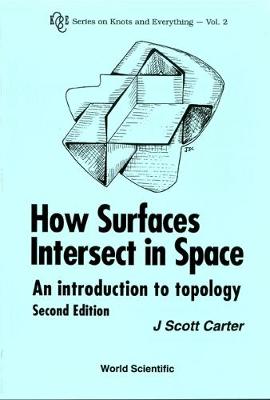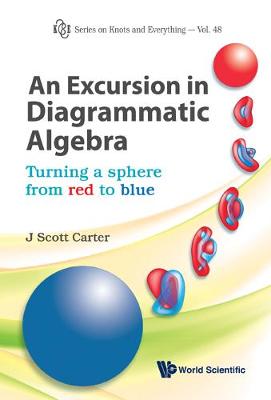Series on Knots & Everything
3 primary works
Book 2
How Surfaces Intersect In Space: An Introduction To Topology (2nd Edition)
by J. Scott Carter
Published 1 January 1995
This marvelous book of pictures illustrates the fundamental concepts of geometric topology in a way that is very friendly to the reader. The first chapter discusses the meaning of surface and space and gives the classification of orientable surfaces. In the second chapter we are introduced to the Moebius band and surfaces that can be constructed from this non-orientable piece of fabric. In chapter 3, we see how curves can fit in surfaces and how surfaces can fit into spaces with these curves on their boundary. Basic applications to knot theory are discussed and four-dimensional space is introduced.In Chapter 4 we learn about some 3-dimensional spaces and surfaces that sit inside them. These surfaces help us imagine the structures of the larger space.Chapter 5 is completely new! It contains recent results of Cromwell, Izumiya and Marar. One of these results is a formula relating the rank of a surface to the number of triple points. The other major result is a collection of examples of surfaces in 3-space that have one triple point and 6 branch points. These are beautiful generalizations of the Steiner Roman surface.Chapter 6 reviews the movie technique for examining surfaces in 4-dimensional space. Various movies of the Klein bottle are presented, and the Carter-Saito movie move theorem is explained. The author shows us how to turn the 2-sphere inside out by means of these movie moves and this illustration alone is well worth the price of the book!In the last chapter higher dimensional spaces are examined from an elementary point of view.This is a guide book to a wide variety of topics. It will be of value to anyone who wants to understand the subject by way of examples. Undergraduates, beginning graduate students, and non-professionals will profit from reading the book and from just looking at the pictures.
Book 2
How Surfaces Intersect In Space: An Introduction To Topology
by J. Scott Carter
Published 1 March 1993
This is a book of marvelous pictures that illustrates standard examples in low dimensional topology. The text starts at the most basic level (the intersection of coordinate planes) and gives hands on constructions of the most beautiful examples in topology: the projective plane, Poincare's example of a homology sphere, lens spaces, knotted surfaces, 2-sphere eversions, and higher dimensional manifolds. The text carefully explains the importance of the examples and the techniques without being bogged down in a morass of technicalities.Chapter 1 opens with the classification of orientable surfaces, and the meaning of space. Chapter 2 discusses examples of non-orientable surfaces including models of the projective plane and the Klein bottle. Chapter 3 discusses how curves fit on surfaces and gives a general discussion of knotted strings in space. In Chapter 4, some examples of other 3-dimensional spaces are described. These include the 3-dimensional sphere, lens spaces, and the quaternionic projective space. In Chapter 5, the author reviews the movie techniques of studying surfaces in 4-dimensions. He shows how to move among the standard examples of Klein bottles, and he gives a "movie move" decomposition of turning the 2-sphere inside out. In the final Chapter, higher dimensional spaces are examined from the same elementary point of view.The book is a guide book to a wide variety of topics. It will be of value to undergraduates who want to learn geometric topology and to graduate students who want examples with which they can make computations and who need an elementary description of topological spaces. Finally, the book should be interesting to other scientists and mathematicians who want to learn some examples of topological spaces.
Book 48
Excursion In Diagrammatic Algebra, An: Turning A Sphere From Red To Blue
by J. Scott Carter
Published 9 December 2011
The aim of this book is to give as detailed a description as is possible of one of the most beautiful and complicated examples in low-dimensional topology. This example is a gateway to a new idea of higher dimensional algebra in which diagrams replace algebraic expressions and relationships between diagrams represent algebraic relations. The reader may examine the changes in the illustrations in a leisurely fashion; or with scrutiny, the reader will become familiar and develop a facility for these diagrammatic computations.The text describes the essential topological ideas through metaphors that are experienced in everyday life: shadows, the human form, the intersections between walls, and the creases in a shirt or a pair of trousers. Mathematically informed reader will benefit from the informal introduction of ideas. This volume will also appeal to scientifically literate individuals who appreciate mathematical beauty.


